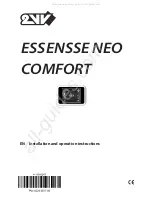
!
USER MANUAL – Release 1.2 of 01/01/2010
Page 146 of 191
Version: 02/03/2010
•
Output 2 is activated for the production of domestic hot water
•
After the delay FS10, the output 1 is deactivated for the production of domestic hot water and
the compressors
•
With delay FS27 seconds, the circulation pump for the domestic hot water is deactivated.
•
After time dF08/2 the status of the 4-way valve is inverted and normal temperature control is
performed.
If there is a production request for chilled water during the production of domestic hot water, the
working will be the same as the previous case.
53.7.4 MANAGEMENT OF THE REFRIGERANT LOAD IN THE CASE OF DOMESTIC HOT WATER
PRODUCTION IN THE SUMMER CYCLE
If there is a production request for domestic hot water during summer working mode, in order to prevent
situations of excess refrigerant “trapped” in the condensing coil, a solenoid valve can be managed (Load
modulation valve – one per circuit), which allows to recover part of the refrigerant trapped until excellent
working conditions are restored. This valve is piloted, depending on over-heating, with the following
procedure:
1. At the time of the AS request, simultaneously with the activation of the relative pump, the condensation
fans are forced to maximum speed (or are kept active at the speed implemented by the condensation
pressure according to settings of parameter FS41). This allows to “store” the largest amount of
refrigerant possible in the condensing coil. If, during this period, the condensing pressure drops below
the threshold FS42 or the evaporation pressure drops below the threshold FS43, the procedure is
suspended and the change over of valves 1 and 2 is immediately started for the production of domestic
hot water.
2. Once the delay has been concluded on the activation of the AS function, the fans are switched-off and
valves 1 and 2 change over
3. Part of the refrigerant present in the coil is put back into circulation for a period of time that can be set
(par FS34) by opening and closing the load modulating valve according to ON and OFF intervals (can
be set via parameters FS39 and FS40). The valve is activated according to this procedure until the
over-heating does not descend below the set FS32 less the band FS33.
4. If the temperature of the chilled water produced is higher than a set-point set at parameter FS35, the set
FS32 with band FS33 are replaced by set FS37 and band FS38.
5. Once the maximum modulation time FS34 has expired, the transitory is considered concluded and the
modulation valve is deactivated.
















































